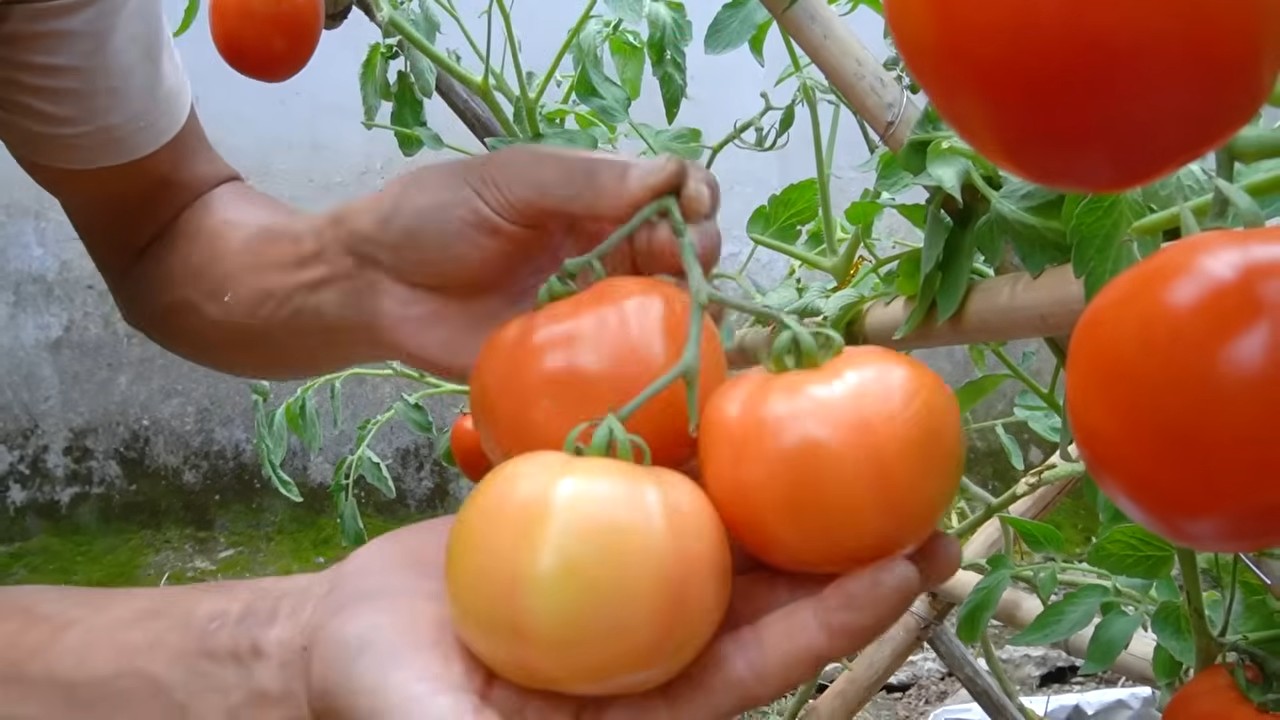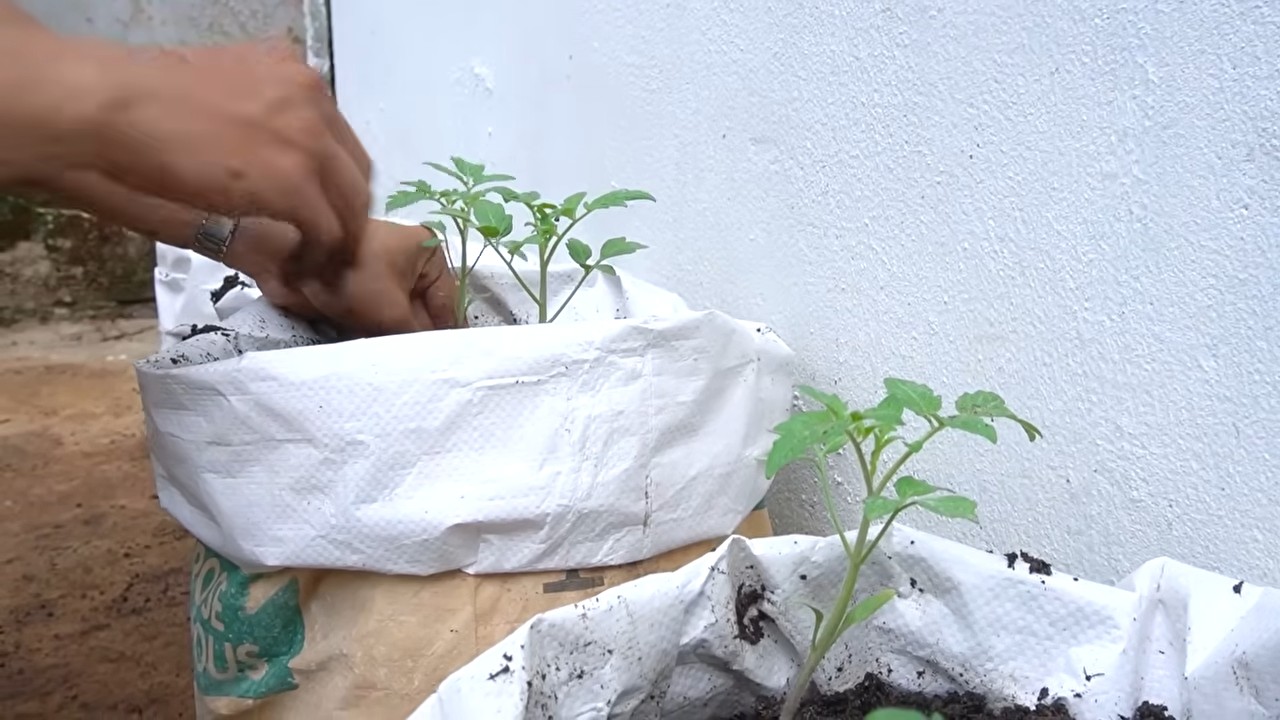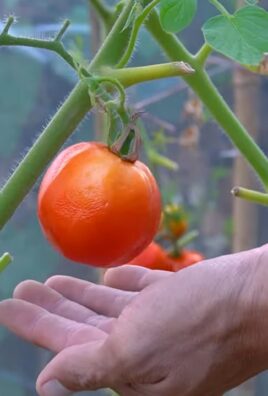Tomato growing secrets are often whispered between seasoned gardeners, passed down through generations like cherished family recipes. But what if I told you that unlocking the juiciest, most flavorful tomatoes wasn’t about luck, but about a few clever DIY tricks and hacks? For centuries, tomatoes have held a special place in our hearts and on our plates, from their origins in South America to their explosion in popularity across the globe. In Italy, they’re practically a symbol of national pride!
But let’s be honest, achieving that perfect, sun-ripened tomato can feel like an uphill battle. Pests, diseases, and unpredictable weather can all conspire against your harvest. That’s where these DIY solutions come in. I’m going to share some of my favorite, tried-and-true methods for maximizing your tomato yield and ensuring a healthy, thriving garden.
Whether you’re a beginner with a small balcony garden or a seasoned pro with acres of land, these tomato growing secrets will empower you to cultivate the tomato crop of your dreams. Forget expensive fertilizers and complicated techniques – we’re focusing on simple, effective, and budget-friendly solutions that anyone can implement. Get ready to transform your tomato growing game!

Unlocking Tomato Growing Secrets: From Seed to Salsa!
Hey there, fellow garden enthusiasts! I’m so excited to share my tried-and-true methods for growing the juiciest, most flavorful tomatoes you’ve ever tasted. Forget those bland, store-bought imposters – we’re talking homegrown goodness that will elevate your salads, sauces, and sandwiches to a whole new level. This isn’t just about planting a seed and hoping for the best; it’s about understanding the needs of your tomato plants and giving them the TLC they deserve. So, grab your gardening gloves, and let’s dive in!
Choosing the Right Tomato Variety
Before we even think about soil, we need to pick the right tomato variety for your climate and preferences. There are literally hundreds to choose from, so it can be a bit overwhelming! Here’s a breakdown to help you decide:
* **Determinate vs. Indeterminate:** This is crucial! Determinate tomatoes grow to a certain size and produce all their fruit at once, making them ideal for canning. Indeterminate tomatoes keep growing and producing fruit throughout the season, perfect for continuous harvests.
* **Heirloom vs. Hybrid:** Heirloom tomatoes are open-pollinated varieties that have been passed down through generations, known for their unique flavors and colors. Hybrid tomatoes are bred for specific traits like disease resistance and higher yields.
* **Size and Shape:** Do you want cherry tomatoes for snacking, beefsteak tomatoes for burgers, or Roma tomatoes for sauce? Consider how you plan to use your tomatoes.
* **Disease Resistance:** Look for varieties labeled with resistance to common tomato diseases like Fusarium wilt (F), Verticillium wilt (V), and Tomato Mosaic Virus (T). This will save you a lot of headaches later on.
My personal favorites include ‘Brandywine’ (heirloom, indeterminate, great flavor), ‘Roma’ (determinate, perfect for sauce), and ‘Sungold’ (cherry, indeterminate, incredibly sweet).
Starting Your Tomato Seeds Indoors (Optional, but Recommended)
Starting your seeds indoors gives you a head start on the growing season, especially if you live in a cooler climate. I highly recommend it!
* **When to Start:** About 6-8 weeks before the last expected frost in your area.
* **What You’ll Need:**
* Seed starting trays or small pots
* Seed starting mix (not regular potting soil!)
* Tomato seeds
* A heat mat (optional, but helpful)
* A grow light (essential!)
* A spray bottle
Step-by-Step Instructions:
1. **Prepare Your Seed Starting Trays:** Fill your trays or pots with seed starting mix, leaving about half an inch of space at the top. Gently tap the trays to settle the mix.
2. **Sow the Seeds:** Make a small indentation (about ¼ inch deep) in the center of each cell or pot. Place 2-3 tomato seeds in each indentation. This increases the chances of at least one seed germinating.
3. **Cover the Seeds:** Gently cover the seeds with seed starting mix.
4. **Water Thoroughly:** Use a spray bottle to moisten the soil. Avoid overwatering, which can lead to damping off (a fungal disease that kills seedlings).
5. **Provide Warmth:** Place the trays on a heat mat (if using) and cover them with a humidity dome or plastic wrap to create a warm, humid environment.
6. **Provide Light:** Place the trays under a grow light. The light should be about 2-4 inches above the soil surface.
7. **Monitor and Water:** Check the soil moisture daily. Keep the soil consistently moist, but not soggy. Remove the humidity dome or plastic wrap once the seeds have germinated.
8. **Thin the Seedlings:** Once the seedlings have developed their first true leaves (the second set of leaves), thin them to one seedling per cell or pot. Choose the strongest, healthiest-looking seedling and snip off the others at the soil line with scissors. Don’t pull them out, as this can disturb the roots of the remaining seedling.
9. **Harden Off the Seedlings:** About a week before you plan to transplant the seedlings outdoors, start hardening them off. This process gradually acclimates them to outdoor conditions. Place the trays outdoors in a sheltered location for a few hours each day, gradually increasing the amount of time they spend outside. Protect them from direct sunlight and strong winds.
Preparing Your Garden Bed
Tomatoes are heavy feeders, so preparing your garden bed properly is essential for a bountiful harvest.
* **Sunlight:** Tomatoes need at least 6-8 hours of direct sunlight per day. Choose a location that receives plenty of sun.
* **Soil:** Tomatoes prefer well-drained, fertile soil with a pH of 6.0-6.8.
* **Amendments:** Amend your soil with plenty of organic matter, such as compost, aged manure, or leaf mold. This will improve drainage, aeration, and nutrient content.
Step-by-Step Instructions:
1. **Clear the Area:** Remove any weeds, rocks, or debris from the garden bed.
2. **Till or Dig the Soil:** Loosen the soil to a depth of at least 12 inches. This will allow the roots to penetrate easily.
3. **Amend the Soil:** Spread a 2-4 inch layer of compost, aged manure, or leaf mold over the soil surface.
4. **Incorporate the Amendments:** Use a garden fork or tiller to incorporate the amendments into the soil.
5. **Test the Soil pH:** Use a soil testing kit to check the pH of your soil. If the pH is too low (acidic), add lime to raise it. If the pH is too high (alkaline), add sulfur to lower it. Follow the instructions on the soil testing kit for application rates.
6. **Add Fertilizer (Optional):** If your soil is particularly poor, you can add a slow-release fertilizer formulated for tomatoes. Follow the instructions on the fertilizer package for application rates.
Transplanting Your Tomato Seedlings
Now for the exciting part – getting those little plants into the ground!
* **When to Transplant:** After the last expected frost and when the soil has warmed up to at least 60°F (15°C).
* **Spacing:** Space determinate tomato plants 2-3 feet apart and indeterminate tomato plants 3-4 feet apart.
* **Support:** Provide support for your tomato plants, such as stakes, cages, or trellises. This will prevent the plants from sprawling on the ground and reduce the risk of disease.
Step-by-Step Instructions:
1. **Dig the Holes:** Dig holes that are slightly larger than the root balls of your tomato seedlings.
2. **Add Compost to the Holes:** Place a handful of compost in the bottom of each hole.
3. **Remove the Seedlings from Their Containers:** Gently squeeze the sides of the containers to loosen the root balls. Carefully remove the seedlings from the containers.
4. **Plant the Seedlings Deep:** Plant the seedlings deep, burying the stem up to the first set of leaves. Tomatoes can develop roots along their stems, which will result in stronger, healthier plants.
5. **Water Thoroughly:** Water the seedlings thoroughly after planting.
6. **Add Mulch:** Apply a layer of mulch around the base of the plants. Mulch will help to retain moisture, suppress weeds, and regulate soil temperature. I like to use straw or shredded leaves.
7. **Install Support:** Install stakes, cages, or trellises to support the plants.
Caring for Your Tomato Plants
Consistent care is key to a successful tomato harvest.
* **Watering:** Water your tomato plants deeply and regularly, especially during hot, dry weather. Aim for about 1-2 inches of water per week. Water at the base of the plants to avoid wetting the foliage, which can promote disease.
* **Fertilizing:** Fertilize your tomato plants every 2-3 weeks with a balanced fertilizer or a fertilizer specifically formulated for tomatoes. Follow the instructions on the fertilizer package for application rates.
* **Pruning:** Prune indeterminate tomato plants to remove suckers (the small shoots that grow in the crotch between the main stem and the branches). This will improve air circulation and encourage fruit production. Determinate tomatoes generally don’t need pruning.
* **Pest and Disease Control:** Monitor your tomato plants regularly for pests and diseases. Common tomato pests include aphids, tomato hornworms, and whiteflies. Common tomato diseases include early blight, late blight, and blossom end rot. Take action promptly to control pests and diseases. I prefer using organic methods whenever possible, such as insecticidal soap, neem oil, and copper fungicide.
* **Blossom End Rot Prevention:** Blossom end rot is caused by a calcium deficiency. To prevent it, ensure your soil has adequate calcium and water your plants consistently. You can also add crushed eggshells to the soil around your plants.
My Secret Weapon: Epsom Salts! I like to give my tomato plants a boost with Epsom salts. Dissolve 1 tablespoon

Conclusion
So, there you have it! Unveiling these tomato growing secrets isn’t just about getting bigger, juicier tomatoes; it’s about transforming your gardening experience. It’s about connecting with nature, understanding the subtle nuances of plant life, and reaping the rewards of your dedication. We’ve explored simple yet powerful techniques, from optimizing sunlight exposure and soil composition to mastering the art of watering and pruning. Each tip, meticulously crafted and time-tested, contributes to a symphony of growth, culminating in a bountiful harvest that will make your neighbors envious.
But why is this DIY approach a must-try? Because it empowers you to take control. You’re no longer reliant on expensive store-bought solutions or vague gardening advice. You’re actively participating in the process, tailoring your approach to your specific environment and needs. This hands-on experience fosters a deeper appreciation for the natural world and a sense of accomplishment that’s hard to replicate. Plus, let’s be honest, there’s nothing quite like the taste of a homegrown tomato, bursting with flavor and sunshine, knowing you nurtured it from seed to table.
Consider these variations to further personalize your tomato growing journey. Experiment with different companion plants, such as basil or marigolds, to deter pests and enhance flavor. Explore the world of heirloom tomato varieties, each with its unique characteristics and stories. Try different pruning techniques to optimize fruit production based on your specific tomato type. You could even delve into the fascinating world of grafting, combining the best traits of different tomato plants for superior results. The possibilities are endless!
Ultimately, the success of your tomato garden hinges on your willingness to experiment, learn, and adapt. Don’t be afraid to make mistakes; they’re valuable learning opportunities. Observe your plants closely, listen to their needs, and adjust your approach accordingly. Remember, gardening is a journey, not a destination. Embrace the process, enjoy the challenges, and celebrate the victories, big or small.
We wholeheartedly encourage you to try these tomato growing secrets and witness the transformation firsthand. Share your experiences with us! Tell us about your successes, your challenges, and your unique adaptations. Let’s create a community of passionate tomato growers, sharing knowledge and inspiring each other to achieve gardening greatness. Post pictures of your bountiful harvests, ask questions, and offer advice. Together, we can unlock the full potential of our tomato gardens and savor the delicious rewards of our labor. So, grab your gardening gloves, get your hands dirty, and prepare to be amazed by the magic of homegrown tomatoes! Your journey to tomato-growing mastery starts now!
FAQ
What if I don’t have a lot of space for a traditional garden?
Don’t worry! These tomato growing secrets are adaptable to various growing environments. Container gardening is an excellent option for those with limited space. Choose large containers (at least 20 gallons) with good drainage. Select determinate tomato varieties, which are more compact and bushier, making them ideal for containers. Ensure your containers receive at least 6-8 hours of sunlight per day. You can also explore vertical gardening techniques, such as using trellises or hanging baskets, to maximize space. Remember to water container-grown tomatoes more frequently, as they tend to dry out faster than those in the ground.
How often should I water my tomato plants?
Watering frequency depends on several factors, including weather conditions, soil type, and plant size. As a general rule, water deeply and infrequently, allowing the soil to dry out slightly between waterings. Aim for about 1-2 inches of water per week, either through rainfall or irrigation. Avoid overhead watering, as it can promote fungal diseases. Instead, water at the base of the plant, directing the water towards the roots. Check the soil moisture regularly by sticking your finger about an inch into the soil. If it feels dry, it’s time to water. During hot, dry weather, you may need to water more frequently.
What are the best types of fertilizer for tomato plants?
Tomato plants are heavy feeders and require a balanced fertilizer to thrive. Look for a fertilizer with an NPK ratio (nitrogen, phosphorus, potassium) that is slightly higher in phosphorus, which promotes root development and fruit production. A 5-10-5 or 10-20-10 fertilizer is a good starting point. You can also use organic fertilizers, such as compost, bone meal, or fish emulsion. Apply fertilizer according to the package instructions, typically every 2-3 weeks during the growing season. Avoid over-fertilizing, as it can lead to excessive foliage growth and reduced fruit production.
How do I deal with common tomato pests and diseases?
Prevention is key when it comes to pests and diseases. Start by selecting disease-resistant tomato varieties. Practice good garden hygiene by removing weeds and debris that can harbor pests and diseases. Use row covers or netting to protect your plants from insects. Regularly inspect your plants for signs of pests or diseases, such as aphids, whiteflies, or tomato hornworms. If you spot any problems, take action immediately. You can use organic pest control methods, such as insecticidal soap or neem oil, to control pests. For diseases, remove infected leaves or plants and apply a fungicide if necessary. Crop rotation can also help prevent soilborne diseases.
When is the best time to harvest my tomatoes?
The best time to harvest tomatoes is when they are fully colored, slightly soft to the touch, and easily detach from the vine. The color will vary depending on the variety, but generally, tomatoes should be a deep red, pink, yellow, or orange. Gently squeeze the tomato; it should give slightly but not be mushy. If the tomato is difficult to pull from the vine, it’s not quite ripe. Harvest tomatoes in the morning, when they are at their coolest. Store ripe tomatoes at room temperature, away from direct sunlight, to preserve their flavor and texture. Avoid refrigerating tomatoes, as it can make them mealy and tasteless.
What if my tomato plants are producing lots of leaves but no fruit?
This is a common problem known as “blossom drop.” It can be caused by several factors, including high temperatures, low temperatures, excessive nitrogen fertilization, or insufficient pollination. To address this issue, ensure your plants are receiving adequate sunlight and water. Avoid over-fertilizing with nitrogen-rich fertilizers. You can also try hand-pollinating your tomato flowers by gently shaking the plants or using a small brush to transfer pollen from one flower to another. If temperatures are consistently high (above 90°F) or low (below 55°F), provide shade or protection to your plants.
Can I save seeds from my homegrown tomatoes?
Yes, you can save seeds from your homegrown tomatoes, but it’s important to understand the difference between hybrid and heirloom varieties. Hybrid tomatoes are the result of cross-pollinating two different parent plants, and their seeds may not produce plants that are true to type. Heirloom tomatoes, on the other hand, are open-pollinated varieties that have been passed down for generations, and their seeds will generally produce plants that are similar to the parent plant. To save seeds, select ripe, healthy tomatoes from your best-performing plants. Scoop out the seeds and pulp and place them in a jar with a little water. Let the mixture ferment for a few days, stirring occasionally. This process will help remove the gelatinous coating around the seeds. Rinse the seeds thoroughly and spread them out on a paper towel to dry completely. Store the dried seeds in an airtight container in a cool, dark place.





Leave a Comment